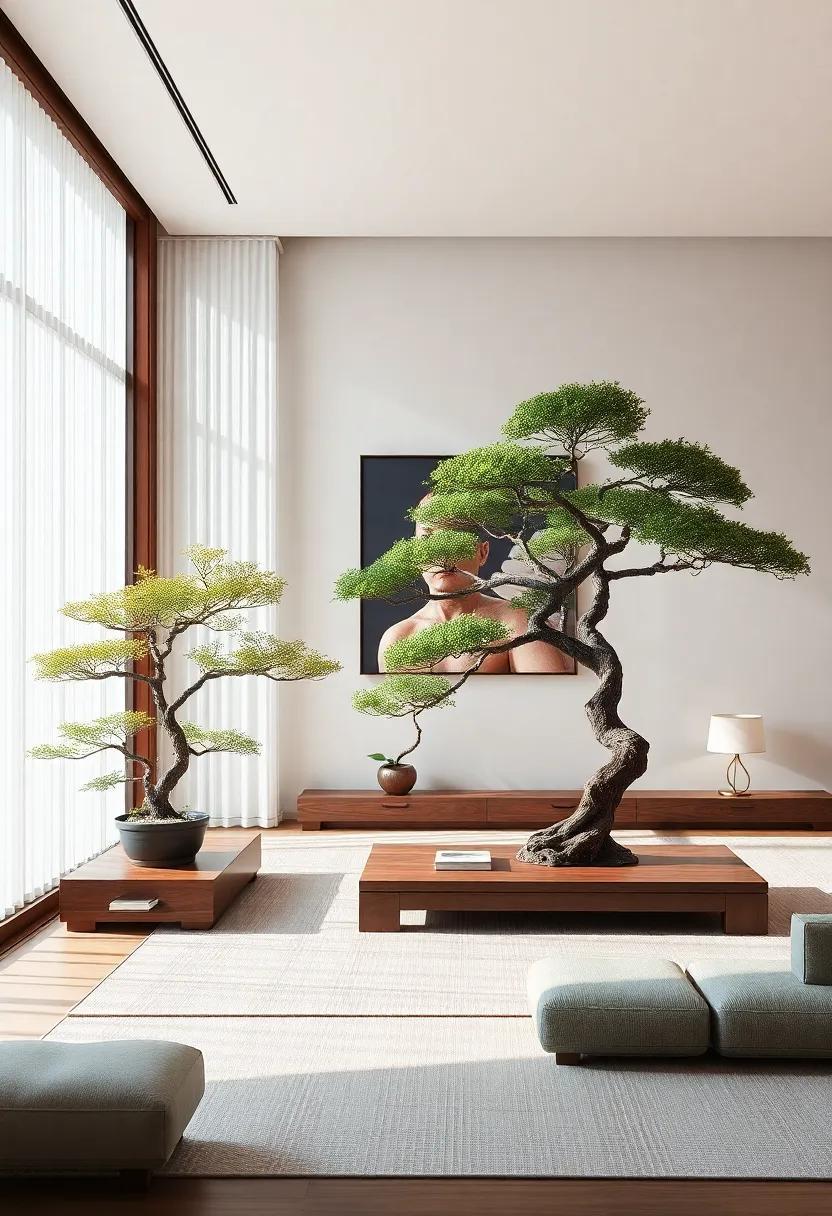
Embracing Tranquility: Designing a Japanese-Inspired Living Room with Bonsai Trees
In an increasingly chaotic world, the allure of tranquility beckons us to seek refuge within our own spaces.Imagine stepping into a living room that exudes serenity, where every detail has been thoughtfully curated to foster peace and harmony. A Japanese-inspired interior, with its understated elegance and natural elements, invites you to slow down and savor the moment. At the heart of this design beliefs lies the bonsai tree—a symbol of patience, balance, and connection to nature. In this article, we will explore the art of designing a tranquil living room infused with Japanese aesthetics, seamlessly incorporating the beauty of bonsai trees to create a serene sanctuary that resonates with calmness and mindfulness.Join us on this journey towards embracing tranquility, and discover how to transform yoru living space into a harmonious oasis.
Embracing minimalism: the Essence of Japanese Design in Living Spaces
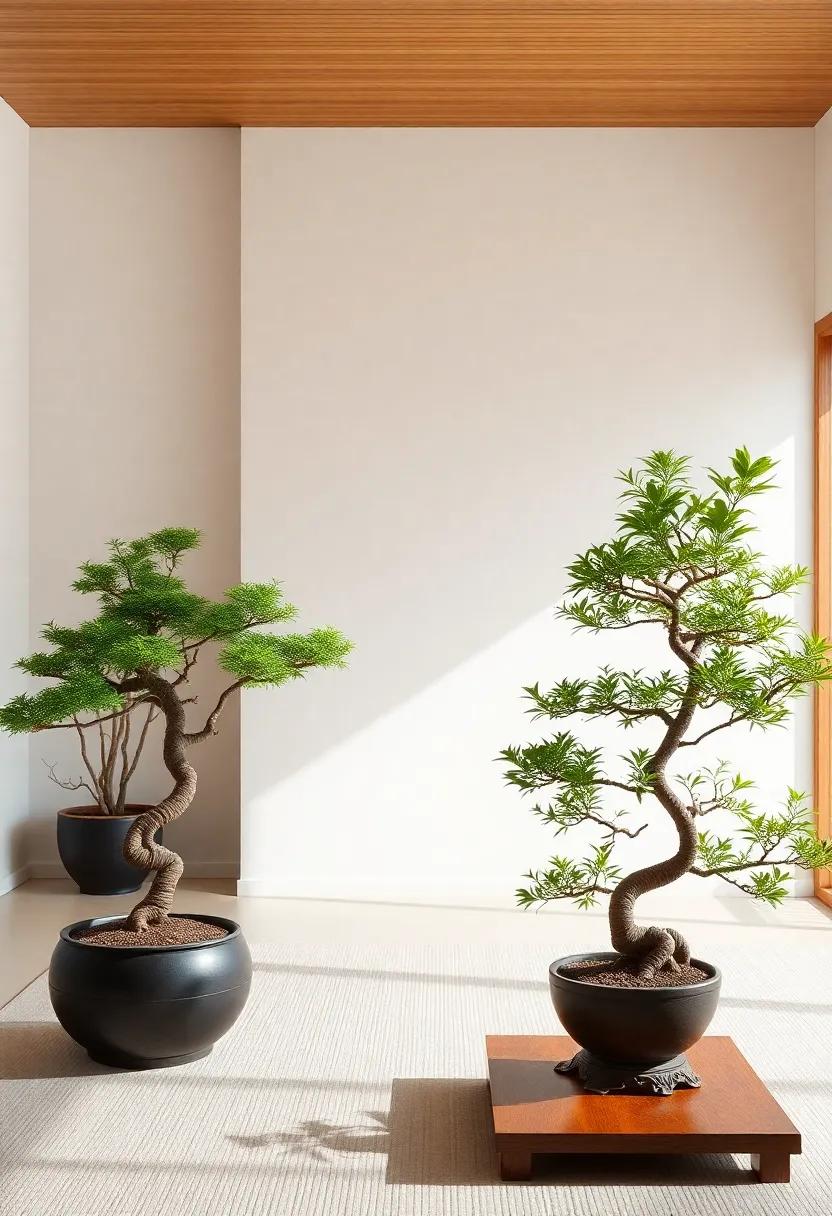
Incorporating the philosophy of minimalism that is so intrinsic to Japanese design is integral when creating a tranquil living space. This aesthetic prioritizes simplicity, emphasizing function and form while eradicating unnecessary clutter. Bonsai trees, a hallmark of Japanese horticulture, serve as perfect companions in this serene surroundings.their small scale invites contemplation and connection to nature, cultivating an atmosphere of peace.To enhance this effect, consider the following elements:
- Natural materials: Use wood, stone, and clay in furnishings for an organic feel.
- Neutral Color Palette: Shades of white, beige, and muted greens promote calmness.
- Open Spaces: Allow for airiness through smart layout design, avoiding overcrowding.
- Soft Lighting: Integrate paper lanterns or dimmable LEDs for a warm glow.
Furthermore, the arrangement of bonsai trees should reflect the principles of balance and harmony found in traditional Japanese gardens.Position them thoughtfully on low tables or window sills where their intricate forms can be appreciated without obstruction. To guide this arrangement, consult the table below illustrating ideal placements:
| Placement Area | Recommended Bonsai Type | Visual Impact |
|---|---|---|
| Low Coffee Table | Ficus Bonsai | Invites casual interaction |
| Window Sill | Juniper Bonsai | Provides natural light appeal |
| Corner Stand | Maple Bonsai | Enhances vertical space |
Harmonizing Nature: Integrating bonsai Trees as Focal Points
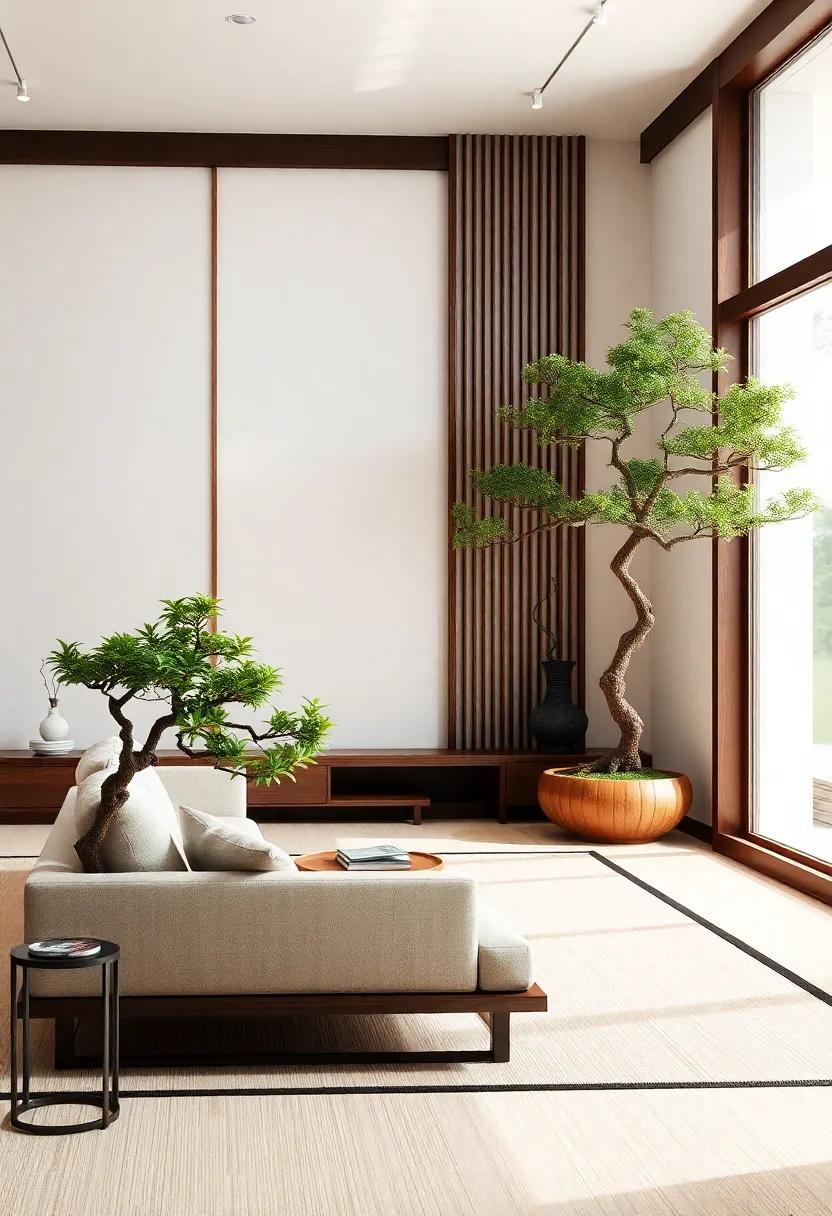
Incorporating bonsai trees as focal points in your living room not only enhances the aesthetic appeal but also embodies the essence of peace and tranquility that defines Japanese design. These miniature masterpieces can create a serene atmosphere, guiding the eye and encouraging mindfulness. Positioning them thoughtfully in various areas within the room can make a significant difference. consider placing them on:
- Side tables: Perfect for creating an inviting corner.
- shelves: Elevate the bonsai to add height and visual interest.
- Windowsills: Allow natural light to nourish the tree while adding charm to the view.
When curating your space,selecting the right type of bonsai is essential. different species offer varying aesthetics and care requirements. For a harmonious setup, consider the following options based on their characteristics:
| Bonsai Species | Visual Appeal | Care Level |
|---|---|---|
| Ficus | Rich green leaves and a robust trunk | Easy |
| Pine | Classic silhouette and textured bark | Moderate |
| Maple | Vibrant fall colors and delicate leaves | Advanced |
By carefully selecting and placing bonsai trees within your living space, you can forge a deeper connection with nature. This approach fosters an environment of mindfulness and harmony, transforming your home into a sanctuary of simplicity and elegance.
Serenity Through Color: A Guide to the Perfect Palette for your Room
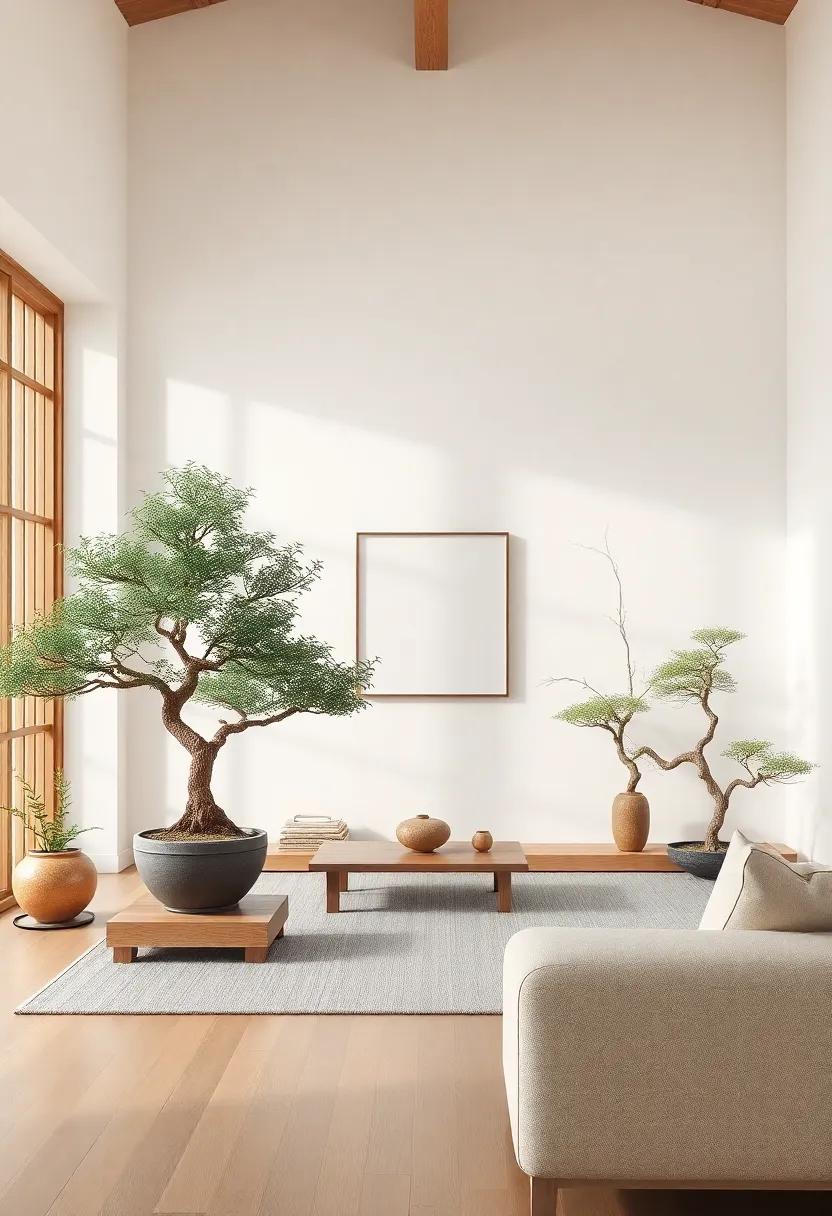
In a Japanese-inspired living room,the choice of colors plays a pivotal role in creating an ambiance that promotes peace and introspection. To achieve this serene atmosphere, focus on soft, natural hues that evoke the tranquility of nature. Consider incorporating colors such as:
- Sage green: Reflects the lush foliage of Japanese gardens.
- Pale Beige: Provides a warm, earthy base reminiscent of tatami mats.
- Muted Blues: Evokes the calmness of water and sky, enhancing a sense of spaciousness.
- Warm Grays: Adds sophistication while maintaining a soft, inviting feel.
Complementing these color choices with natural materials will further enhance the overall aesthetic. Incorporate elements like wood, stone, and textiles to create a cohesive look. Arranging bonsai trees strategically around the room not only introduces greenery but also serves as living art pieces that reflect the japanese philosophy of harmony and balance. Utilize a simple color palette to allow these bonsai trees to stand out, ensuring they become focal points that invite mindfulness and meditation into your space. Remember to keep decor minimal and intentional, allowing your chosen palette to guide your design choices.
Textures That Soften: Choosing fabrics and Materials for Comfort
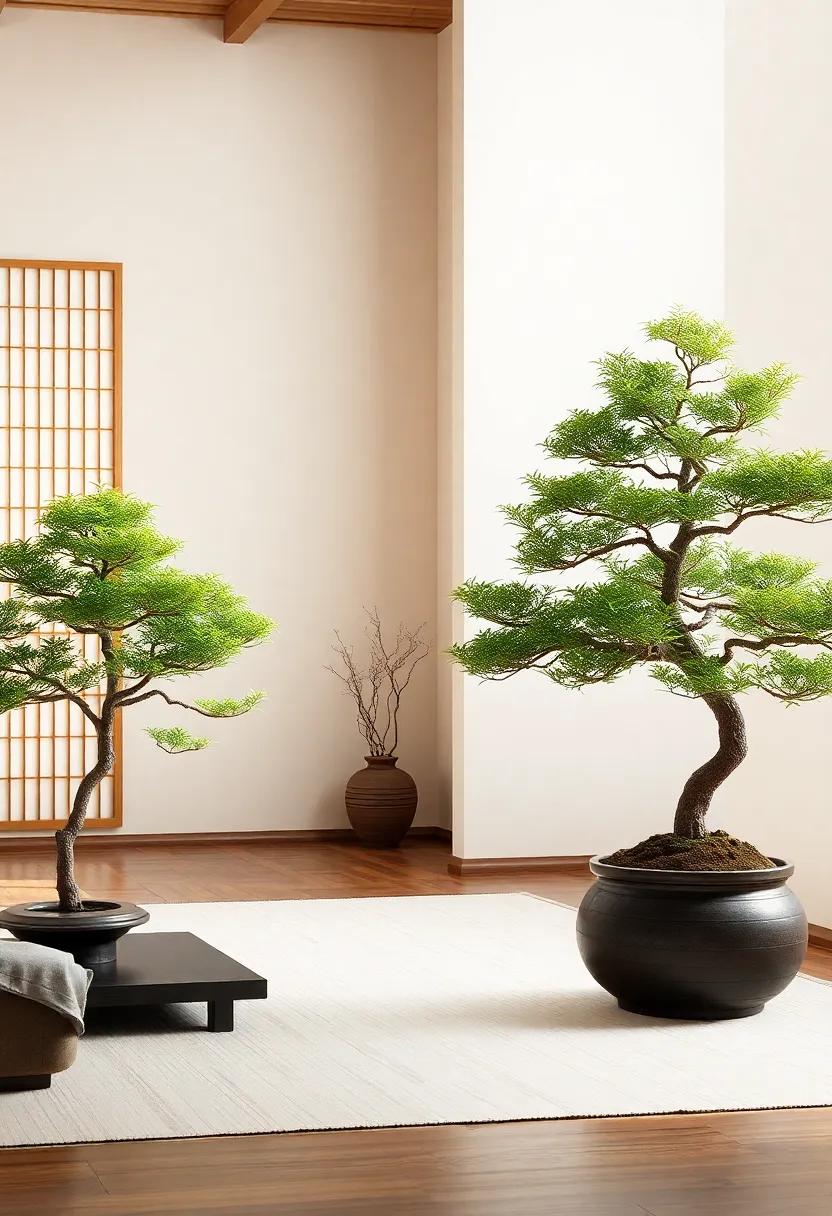
When designing a space rooted in tranquility,the choice of fabrics and materials plays a crucial role in achieving the desired sense of comfort and serenity. Selecting natural fibers such as cotton, linen, and silk not only enhances the tactile experience but also promotes a calming aesthetic. These materials invite a softness that echoes the gentle spirit of traditional Japanese interiors. Consider layering various textures to create depth while maintaining a harmonious atmosphere. A woven rug, plush cushions, and lightweight throws can transform the living room into a soothing retreat.
Additionally, the integration of wood and stone can complement soft textiles, contributing to an organic feel. opt for lasting options like bamboo or reclaimed wood for furniture pieces, which offer not only durability but also an earthy warmth. Incorporating elements such as cotton canvas or ramie for curtains can provide a delicate filtration of light, enhancing the serene environment. Below is a simple comparison table to highlight some fabrics to consider in your design:
| Fabric/Material | Texture | Benefits |
|---|---|---|
| Cotton | Soft, Breathable | Easy to clean, hypoallergenic |
| Linen | Textured, Lightweight | Durable, moisture-wicking |
| Silk | Luxurious, Smooth | Elegance, natural sheen |
| Bamboo | Sleek, Sustainable | Eco-friendly, antimicrobial |
Zen Elements: Incorporating Water Features for a Calming Atmosphere
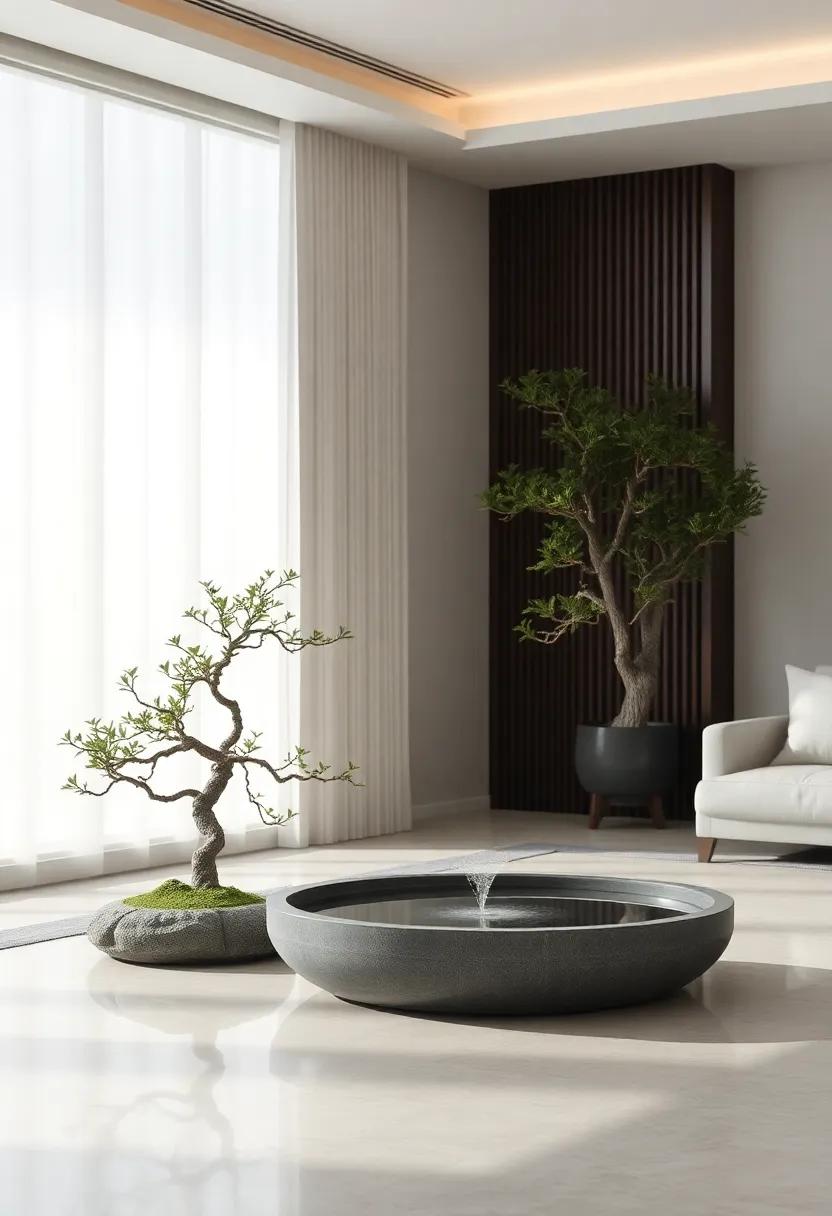
Water features serve as a dynamic element in creating a serene ambiance, enhancing the overall tranquility of a Japanese-inspired living room. Whether you choose a small tabletop fountain or a larger Koi pond, the gentle sound of flowing water acts as a natural sound barrier, promoting relaxation and introspection. Incorporating soft lighting around these features can further highlight their beauty, casting soothing reflections and shadows that dance across the room. Consider the following additions to make your space feel more harmonious:
- Tabletop Water Fountain: Ideal for smaller spaces, these can easily integrate on a coffee table or shelf.
- Wall-mounted Waterfalls: Create a stunning focal point and can save floor space.
- Zen Gardens with Water Elements: Combine sand, stones, and a small water basin for a full sensory experience.
To maintain the essence of nature indoors, pay attention to the placement of your water features. Positioning them near Bonsai trees or natural stone accents enhances the organic feel of the environment. The water provides a mirror-like surface that reflects the lush greenery of your Bonsai, creating a living artwork that invites mindfulness. By carefully curating the arrangement of plants, stones, and water, you can achieve a perfect harmony that embodies the principles of Japanese aesthetics:
| Element | Impact on Atmosphere |
|---|---|
| Water Features | Promotes relaxation and gentle sound |
| Bonsai Trees | Encourages mindfulness and appreciation for nature |
| Natural stones | Provides texture and earthiness |
Natural Light: Creating an Inviting space with Strategic Window Designs

Natural light plays a pivotal role in creating an inviting atmosphere, especially in a Japanese-inspired living room adorned with bonsai trees.By incorporating large windows or strategically designed shoji screens, you can invite the sun’s warmth and gentle glow into your space. This allows the natural beauty of the bonsai trees to become a focal point, enhancing their intricate shapes and textures. Furthermore,consider using adjustable window coverings that enable you to control the light intensity,creating a serene ambiance that complements the tranquil nature of Japanese design. Embrace elements such as:
- Translucent shoji screens that filter light and add elegance.
- Floor-to-ceiling windows that blur the boundary between indoors and outdoors.
- Strategic plant placement to maximize the visual impact of sunlight.
To elevate the effectiveness of natural light, consider the orientation of your windows. South-facing windows will absorb the most light throughout the day,while east-facing options provide a gentle morning sun,creating a peaceful start to your day. implementing a color palette that reflects the soothing tones of nature can further enhance this effect. Soft greens, earthy browns, and subtle creams will amplify the natural feel of the space. The table below summarizes the ideal window orientations and their corresponding benefits:
| Orientation | Benefits |
|---|---|
| South | Maximum sunlight; warm ambiance. |
| East | Gentle morning light; energizing start. |
| West | Rich evening light; dramatic sunsets. |
| north | Consistent, diffused light; ideal for bonsai. |
Arranging Balance: The Art of Layout in a Japanese-Inspired Living Room
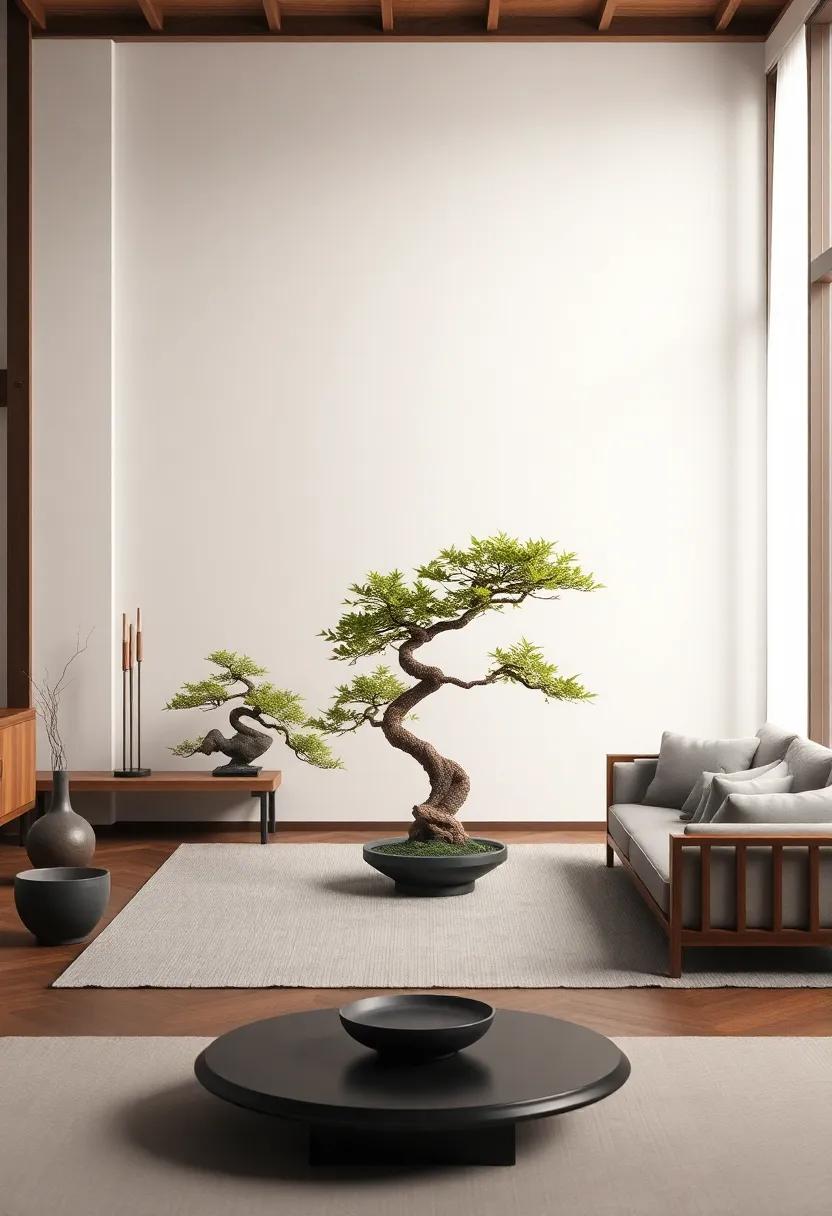
In a japanese-inspired living room, the layout plays a crucial role in establishing an atmosphere of serenity and balance. To achieve this, consider the use of natural materials such as wood, stone, and paper, which create a harmonious environment. Focus on open spaces that encourage movement and tranquility, avoiding the clutter that can disrupt the peace. Traditional Japanese furniture is usually low to the ground, like tatami mats and low tables, which fosters a grounded connection to the earth and enhances the sense of spaciousness. Positioning your furniture to facilitate interaction while maintaining a serene environment is key; for example, arrange seating to encourage conversation while keeping pathways clear and unobstructed.
incorporating bonsai trees as focal points not only enhances visual interest but also brings an element of nature indoors, which is fundamental in Japanese design. When arranging these plants, consider the following guidelines to maintain balance:
- Choose a variety of sizes for visual diversity
- Group them by height to establish layers
- Align them with natural light sources, ensuring they receive adequate sunlight
- Create symmetry in their placement to promote a calming ambiance
A well-planned layout allows your bonsai to shine as a living art piece, evoking contemplation and peace. By carefully arranging each element in your living room,you can cultivate an inviting atmosphere that invites relaxation and mindfulness.
Cultural Touchstones: Incorporating traditional Japanese Decor
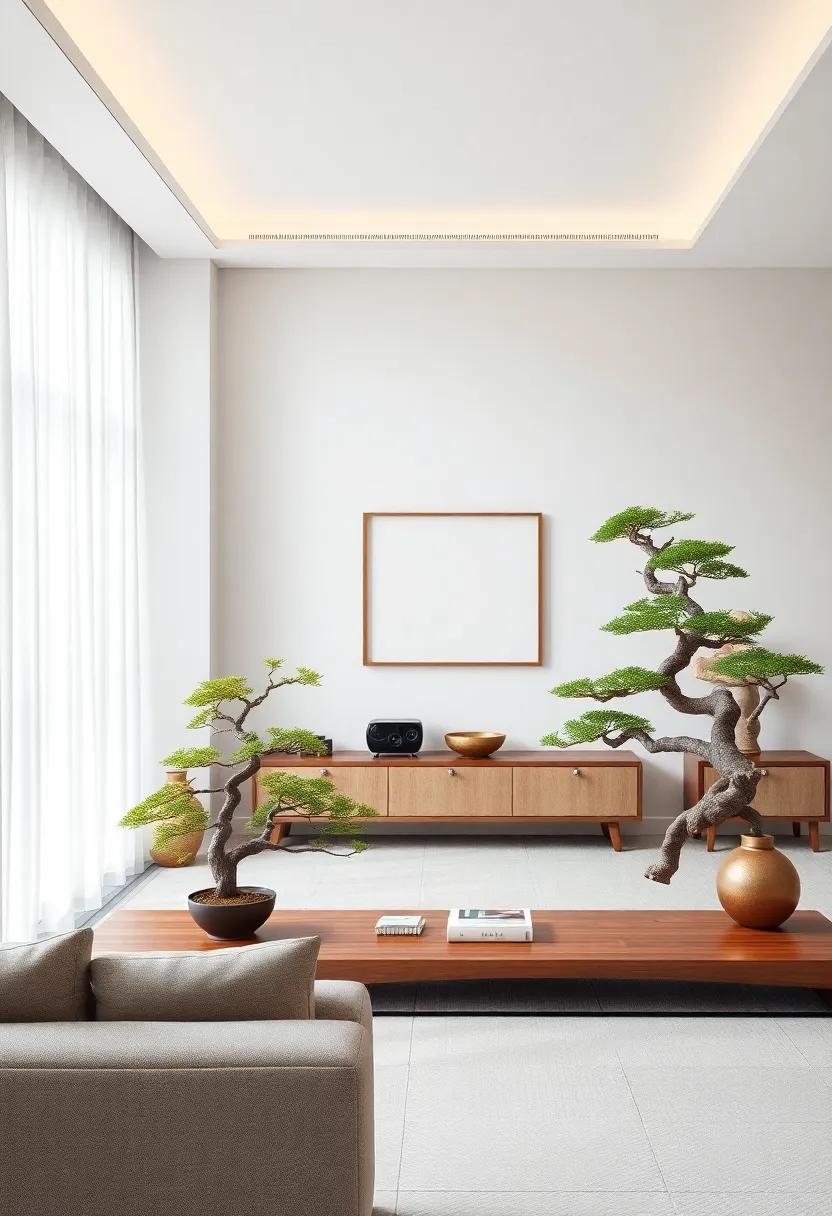
to achieve a serene and harmonious atmosphere in your living room, consider incorporating elements of traditional Japanese decor. A shoji screen can serve as a stunning partition,allowing natural light to filter through while maintaining privacy. This delicate art of sliding panels not only enhances spatial flow but also offers a fraction of tranquility that is characteristic of Japanese aesthetics. Another valuable addition is the tatami mat,made from rice straw and covered with woven rush grass. Its natural texture brings warmth to the space, inviting barefoot walks and a connection to the earth.
Artful displays can further accentuate the Japanese influence in your design. Choose a kintsugi vase, which celebrates imperfections and highlights crack lines with gold or silver lacquer. Pair it with Bonsai trees—these meticulously pruned plants represent harmony, balance, and patience, perfectly encapsulating the essence of Japanese philosophy. Consider adding elements such as furoshiki (traditional wrapping fabric) patterns on cushions or artwork displays that showcase sumi-e (ink wash painting). These subtle details create a cohesive narrative, transforming your living room into a sanctuary of peace and introspection.
Living with Nature: Enhancing Your Space with Indoor Plants
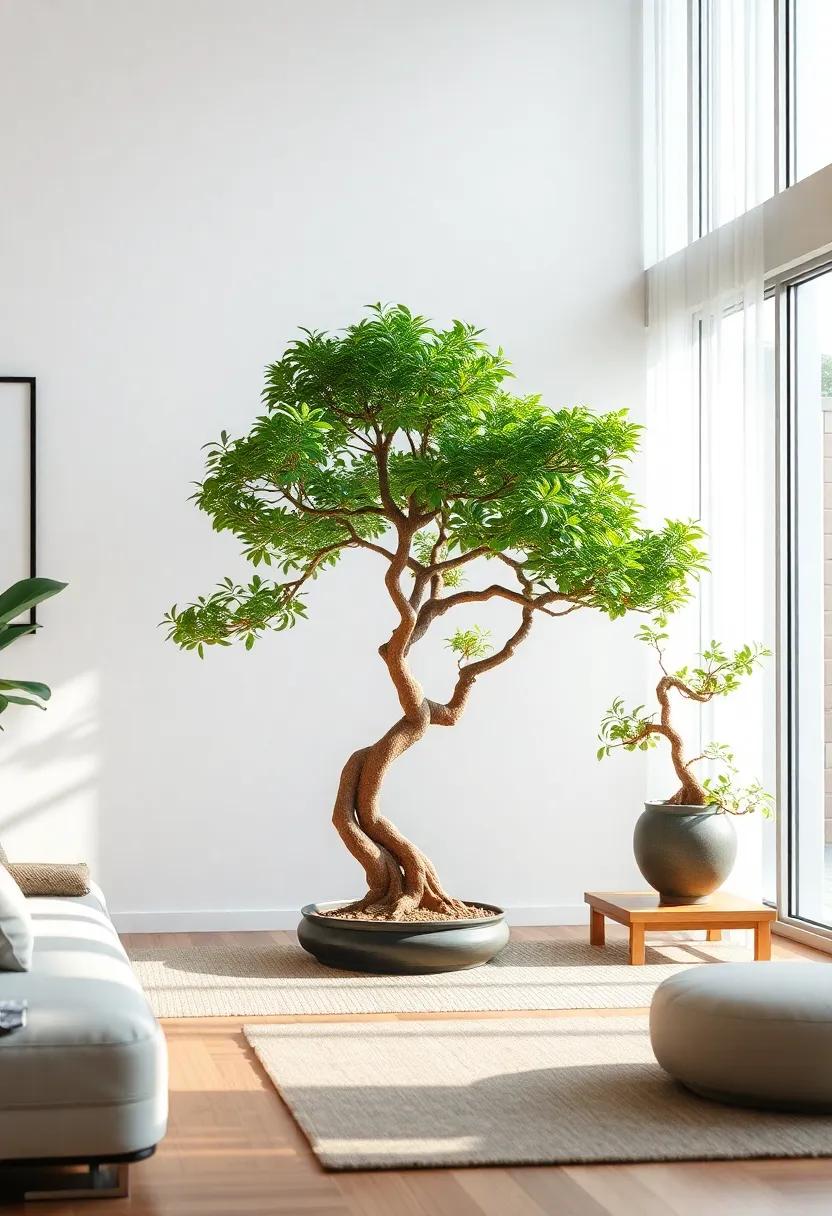
Integrating bonsai trees into your living room design not only enhances the aesthetic appeal but also promotes a sense of tranquility and mindfulness. To create a harmonious space, consider positioning your bonsai where they can be admired yet are easy to maintain. Floating shelves, corner nooks, or coffee tables can serve as ideal spots, allowing these miniature trees to act as striking focal points. Incorporate a variety of sizes and shapes to establish a dynamic visual interplay, fostering a natural rhythm that invites calmness into your environment.
Along with the plants themselves, the supportive decor elements play a crucial role in embodying the essence of a japanese-inspired living room. consider these key components:
- Natural Materials: Use wood, stone, and rice paper for furniture and accents to create an organic atmosphere.
- Soft Lighting: Opt for warm, diffused lighting through pendant lamps or paper lanterns to enhance relaxation.
- Minimalist Decor: Choose decorative items wisely; a few well-placed art pieces or ceramics can maintain simplicity while showcasing elegance.
To assist you in your design journey, here’s a simple table outlining tips for bonsai care to maintain their vitality:
| Care Aspect | Details |
|---|---|
| Watering | Keep the soil moist but not soggy; check regularly. |
| Lighting | Place in bright, indirect sunlight; avoid direct harsh rays. |
| Trimming | Regularly prune leaves and branches to maintain shape and health. |
Calm Corners: Designing a Cozy Reading Nook Inspired by zen
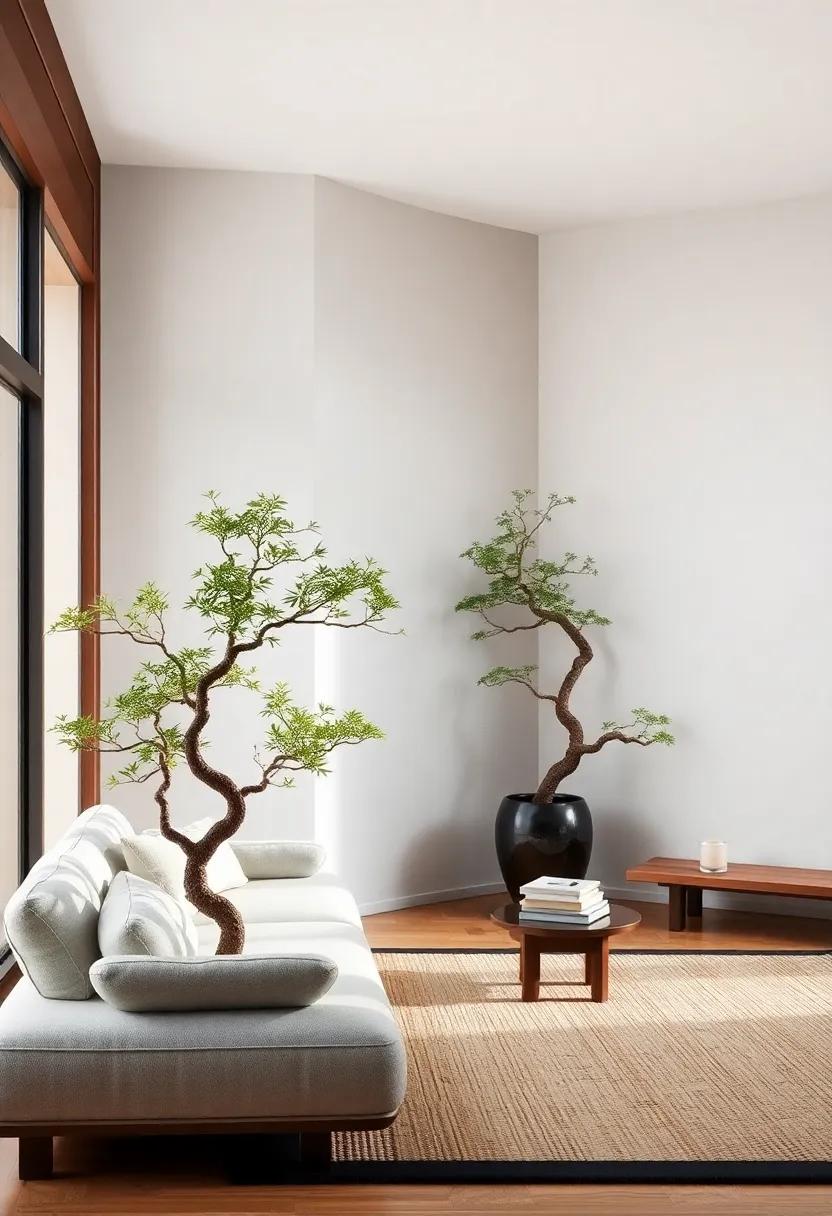
Transform your reading space into a serene retreat that encourages mindfulness and reflection. Start with a soft floor cushion or a low armchair to provide comfort while you dive into your favorite books. Surround this seating with natural elements: a minimalistic wooden side table for your tea or coffee, and an array of potted plants to bring life and color. Opt for shades of soft greens and warm browns to evoke a sense of calm. Incorporate warm lighting, such as a paper lantern or a soft-glow LED lamp, to further enhance the atmosphere. A small bookshelf, styled with your treasured reads, can serve as both a functional and beautiful focal point.
To complete this tranquil space,consider adding decorative items that reflect Japanese aesthetics. Incorporate items such as:
- Succulent terrariums for low-maintenance greenery
- Woven baskets for an organic touch
- Soft textiles such as an inviting throw blanket to add warmth
- Zen sand garden for an interactive focal point
A small table, crafted from dark wood, can provide the perfect spot for your bonsai tree, symbolizing harmony and balance. By implementing these thoughtful elements, your reading nook will become a personal haven for relaxation, inviting you to escape into the world of literature while cultivating a peaceful state of mind.
Layered Lighting: Crafting an Ambience That Encourages Relaxation
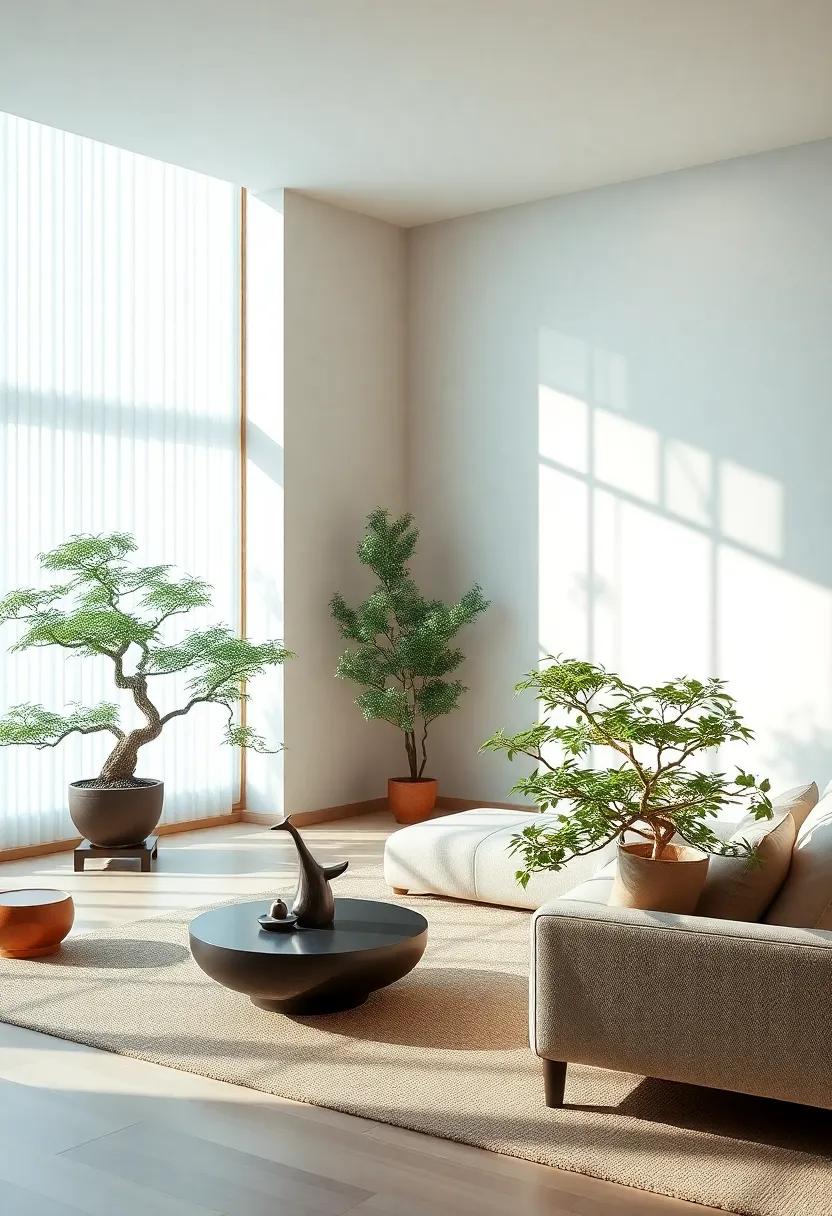
To achieve a serene and inviting atmosphere in your Japanese-inspired living room, consider utilizing a three-layered lighting approach. This method integrates ambient, task, and accent lighting to create depth and harmony.Start with ambient lighting, which serves as the foundation of your design; soft, warm overhead fixtures, like a rice paper pendant lamp, can provide gentle illumination reminiscent of traditional Japanese homes. pair this with task lighting—minimalist floor lamps or strategically placed table lamps that offer focused light for reading or unwinding in the evening.
To enhance the tranquil setting, incorporate accent lighting to highlight the exquisite features of your space, such as a beautifully shaped bonsai tree or a delicate piece of art.Use adjustable spotlights or LED strip lights gracing shelves to draw attention to these elements, creating an inviting focal point. Additionally, consider using dimmer switches to control light intensity, allowing you to transition from lively gatherings to peaceful moments of solitude. By layering these various light sources, you not only promote relaxation but also evoke the serene beauty found in traditional Japanese aesthetics.
artful Simplicity: Selecting Wall Decor that Complements Bonsai Trees
In creating a harmonious balance within a Japanese-inspired living room, wall decor plays a crucial role in enhancing the tranquility that bonsai trees embody. Opt for minimalistic artwork that draws inspiration from nature or traditional Japanese motifs. Consider pieces that feature landscapes, serene waterscapes, or delicate brushwork, all designed to visually connect with the organic beauty of your bonsai. Incorporating elements that echo the smooth lines and gentle curves of the bonsai creates a seamless transition throughout the space.
Additionally, incorporating natural materials such as wood and stone in your wall decor can further enhance the serene aesthetics. Think of using bamboo frames or textured wooden panels that echo the tranquil themes of your plants. Here are some decor ideas to consider:
- Nature-inspired prints: Botanical illustrations or watercolor landscapes.
- Textured wall hangings: Woven fabrics or macrame that add softness.
- Minimalist shelving: Floating shelves to display small bonsai or related decor.
For an organized visual layout, you might consider a display table that highlights elements of your decor:
| Type of Decor | Description |
|---|---|
| Art Prints | Simple landscapes that complement the calm of bonsai. |
| Wooden Panels | Textured backdrops that echo natural elements. |
| Shelves | Minimal design to keep focus on the bonsai trees. |
Earthy Accessories: Choosing Decorative Elements that Reflect Nature
To truly embrace the essence of nature within your Japanese-inspired living room, consider integrating earthy accessories that echo the serene elements of your surroundings. Decorative pieces such as textured ceramic vases, soft bamboo mats, and smooth wooden sculptures can ground your space and establish a natural harmony. opt for colors that mimic earth tones, which effortlessly blend with the greens of your bonsai trees, creating a cohesive look that calms the mind and soothes the soul. You might also want to explore incorporating natural materials into your decor,such as:
- Stone accents – Small pebbles or larger stones can enhance tranquility.
- Woven textiles – Cushions or throws in linen or jute add warmth.
- Organic artwork – Nature-inspired prints or watercolor pieces can infuse beauty.
In addition to small decor items, consider creating zones within the room that feature larger decorative elements. Elements such as a water feature or an indoor rock garden can introduce fluidity and tranquility into the space. below is a simple layout that outlines how you can arrange these features alongside your bonsai display:
| Zone | Element | Purpose |
|---|---|---|
| Seating Area | Bamboo Mats | Comfort and natural texture |
| Display Corner | Stone Accents | Invoke a sense of grounding |
| Focal Point | Indoor Rock Garden | Enhance tranquility and focus |
By thoughtfully choosing and positioning these earthy accessories, you can create a living environment that not only honors the bonsai’s delicate nature but also fosters a deep connection to the tranquility of the natural world.
The Sound of Silence: Designing Acoustic Spaces for Peaceful Living
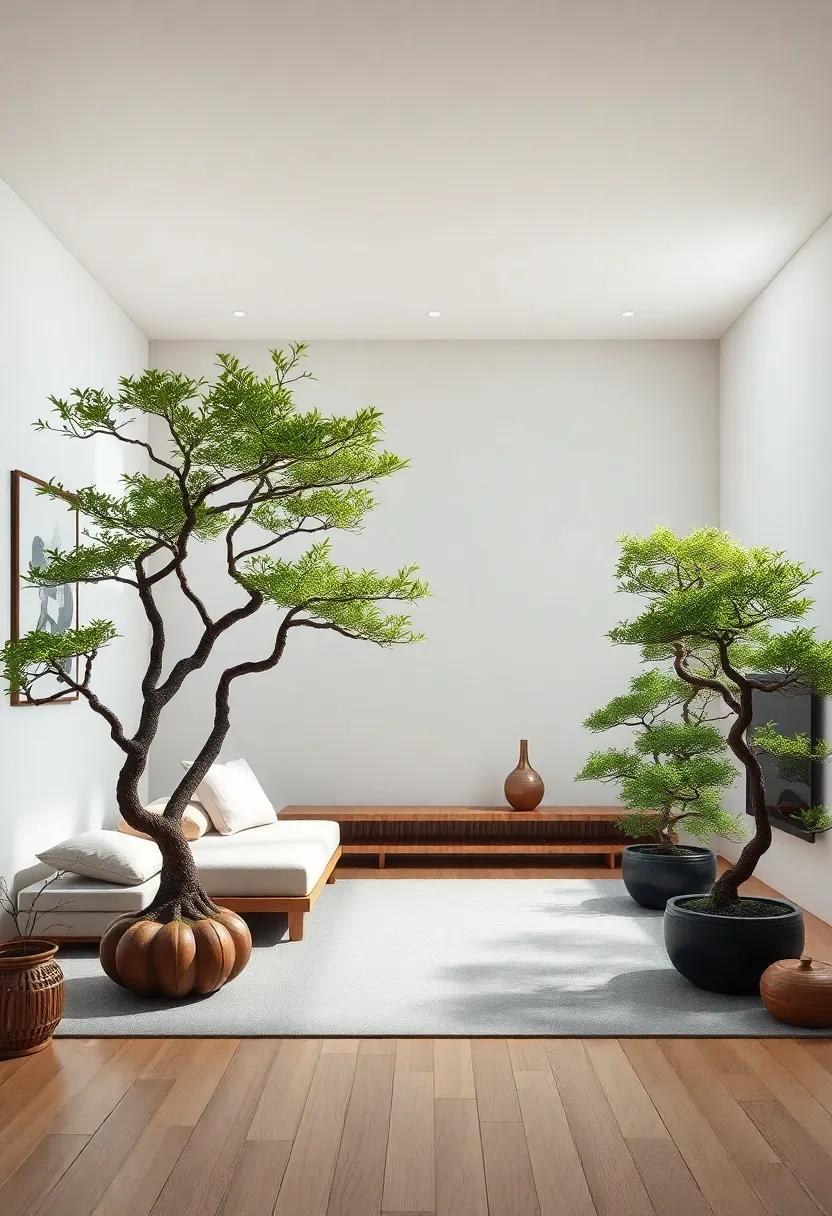
Creating a harmonious environment that fosters tranquility involves carefully considering both aesthetic elements and acoustic design. To achieve this, one can incorporate natural materials such as bamboo, wood, and rice paper, which not only evoke a serene Japanese atmosphere but also help absorb sound. Soft textiles, like tatami mats and silk cushions, can further diminish noise and create a warm, inviting space. The strategic placement of bonsai trees not only adds a touch of nature but also serves as natural acoustical diffusers, breaking up sound reflections and contributing to a peaceful ambiance.
When arranging your Japanese-inspired living room, consider implementing feng shui principles to enhance the flow of energy, or “chi.” A balanced layout might include a central seating area surrounded by these live green sculptures, creating a visual and auditory oasis. Use a simple color palette with muted tones,allowing the eye to relax without overstimulation. Below is a table to guide you through showcasing sounds and elements that enhance your peaceful living experience:
| Element | Sound Effect | Impact |
|---|---|---|
| Water Features | Gentle trickling | Relaxes the mind and body |
| Bonsai Trees | Soft rustling leaves | Enhances connection to nature |
| Textiles | Absorbing sound | Muffles harsh echoes |
| Wooden Elements | Warm resonance | Creates an organic feel |
Seasonal Shifts: Adapting Your Room’s Decor Throughout the Year
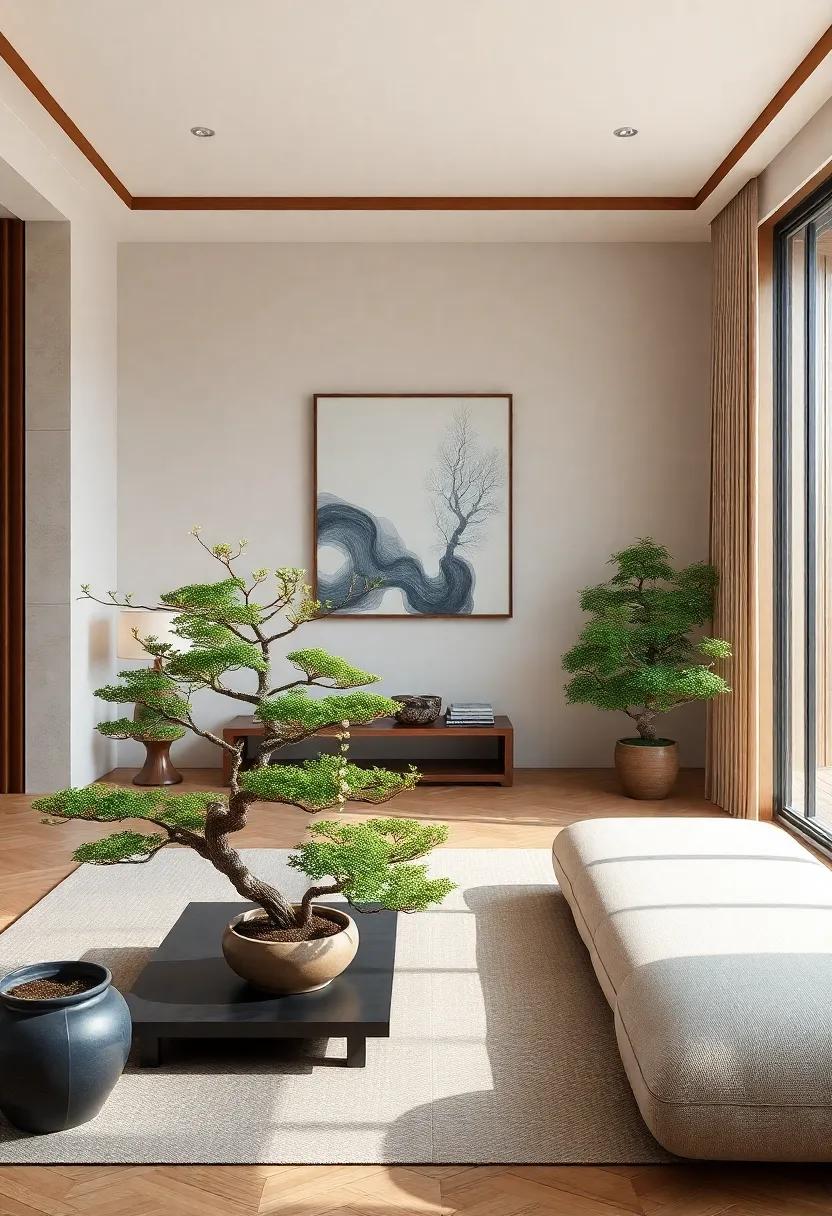
As the seasons change, so too can the ambiance of your living room, allowing for a refreshing update that enhances the tranquility inspired by a Japanese aesthetic. In spring, consider introducing elements that reflect the blossoming nature outside. Fresh floral arrangements like cherry blossoms or delicate peonies can add a splash of color, while light, pastel textiles in cushions and throws evoke the softness of the season. Embrace natural light by keeping window treatments airy and translucent, creating a peaceful backdrop for your exquisite bonsai trees.
Summer invites warmth and vitality, making it the perfect time to incorporate a palette of warm earth tones. Use fabric that is light yet textured, such as linen or cotton for cushions, to maintain a sense of comfort. To enhance the Japanese influence, introduce items like a small shoji screen to partition spaces, or place bamboo mats for a natural feel. In the autumn, consider rich hues like burnt orange and deep brown, reflected in decorative items such as ceramic pots for your bonsai or seasonal art pieces.Transitioning into winter brings an invitation to pair these elements with cozy, thicker throws and perhaps a soft lighting scheme that highlights the beauty of your carefully curated bonsai arrangements, encapsulating a serene environment all year round.
Mindful spaces: Creating Zones for Meditation and Reflection
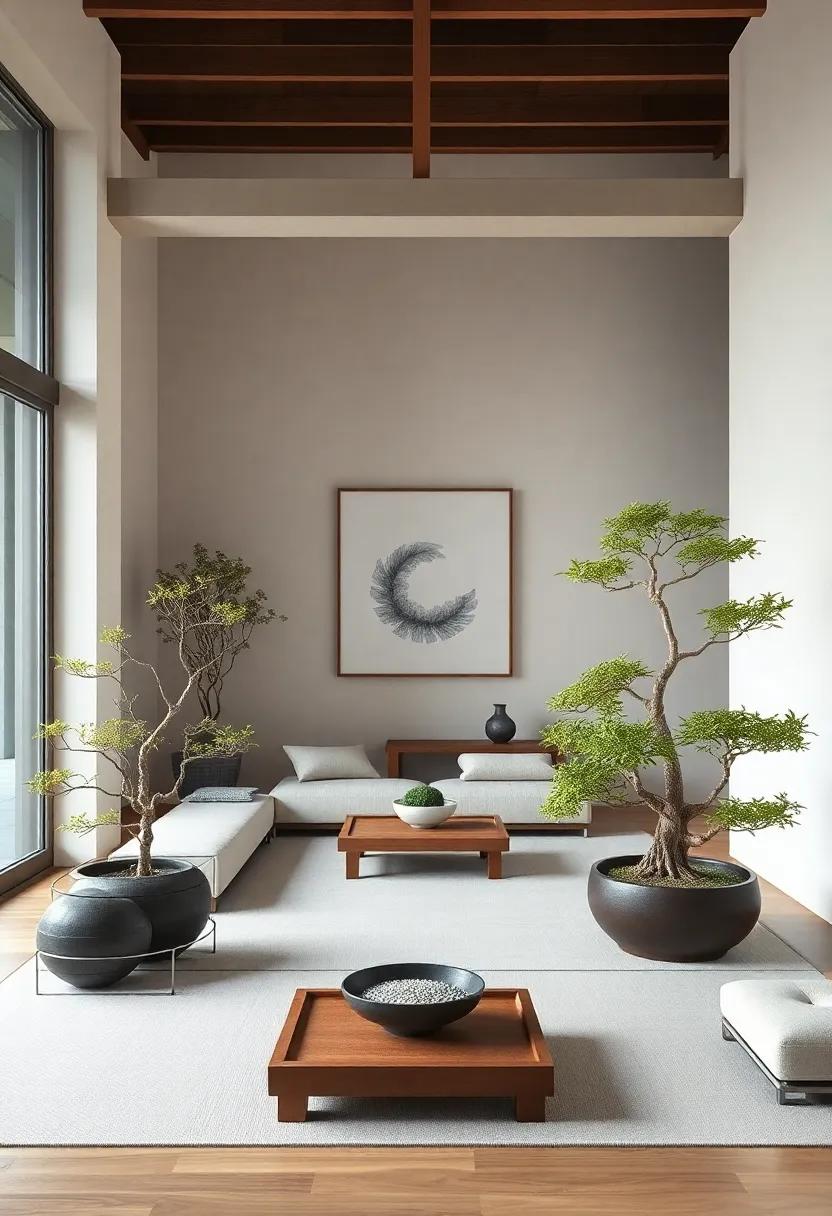
To cultivate a serene atmosphere conducive to meditation and reflection, consider incorporating designated corners or alcoves within your living room. arrange cozy seating options such as floor cushions, tatami mats, or a low wooden bench that invites stillness. Surround these areas with calming elements such as a small water feature or a shoji screen to create visual privacy. Enhance the ambiance with soft, natural light filtered through sheer fabrics, ensuring the space remains inviting yet tranquil.
Utilize bonsai trees as living focal points, placing them strategically to inspire mindfulness. Their intricate forms encourage reflection and serve as a reminder of nature’s beauty. Additionally, consider integrating a simple table to hold meditation supplies or journals, allowing for a seamless transition from contemplation to written reflection.To further enhance this sanctuary,aromatic elements such as essential oils or candles can promote a soothing environment,helping to ground your thoughts and enhance your overall mindfulness practice.
Timeless Furniture: Investing in Pieces That Enhance Tranquility
Investing in timeless furniture is essential for creating a serene atmosphere,especially in a Japanese-inspired living space. Each piece should not only complement the minimalistic design that characterizes traditional Japanese aesthetics but also evoke a sense of calmness and serenity. Consider incorporating furniture made from natural materials like wood, bamboo, and stone.These elements help bridge the gap between indoor and outdoor environments, enhancing the tranquil feel of your living room. Key items to consider include:
- Low-profile tatami mats: Perfect for grounding the space while providing a soft, inviting surface.
- Minimalist wooden coffee tables: Choose those with clean lines and a natural finish to emphasize simplicity.
- Comfortable yet understated seating: Opt for cushions or low sofas that encourage relaxation.
- Functional storage solutions: Think shelving that showcases your bonsai trees and keeps clutter at bay.
to further enhance this tranquil environment,it’s significant to choose furniture that encourages mindfulness and reflection. incorporating a few artisan-crafted pieces, such as a handcrafted bench or an elegantly designed side table, can considerably contribute to the overall aesthetic while maintaining functionality. Below is a selection of timeless furniture pieces that harmonize beautifully in a Japanese-inspired living room:
| Furniture Piece | Material | Key Feature |
|---|---|---|
| Tatami Mats | Rice Straw | Natural Texture |
| Low Coffee Table | reclaimed Wood | Sleek Design |
| Zen Bench | Bamboo | Space-Saving |
| Built-in Shelving | Plywood | Functional Display |
Bonsai Varieties: selecting the Right Trees for Your Living Room
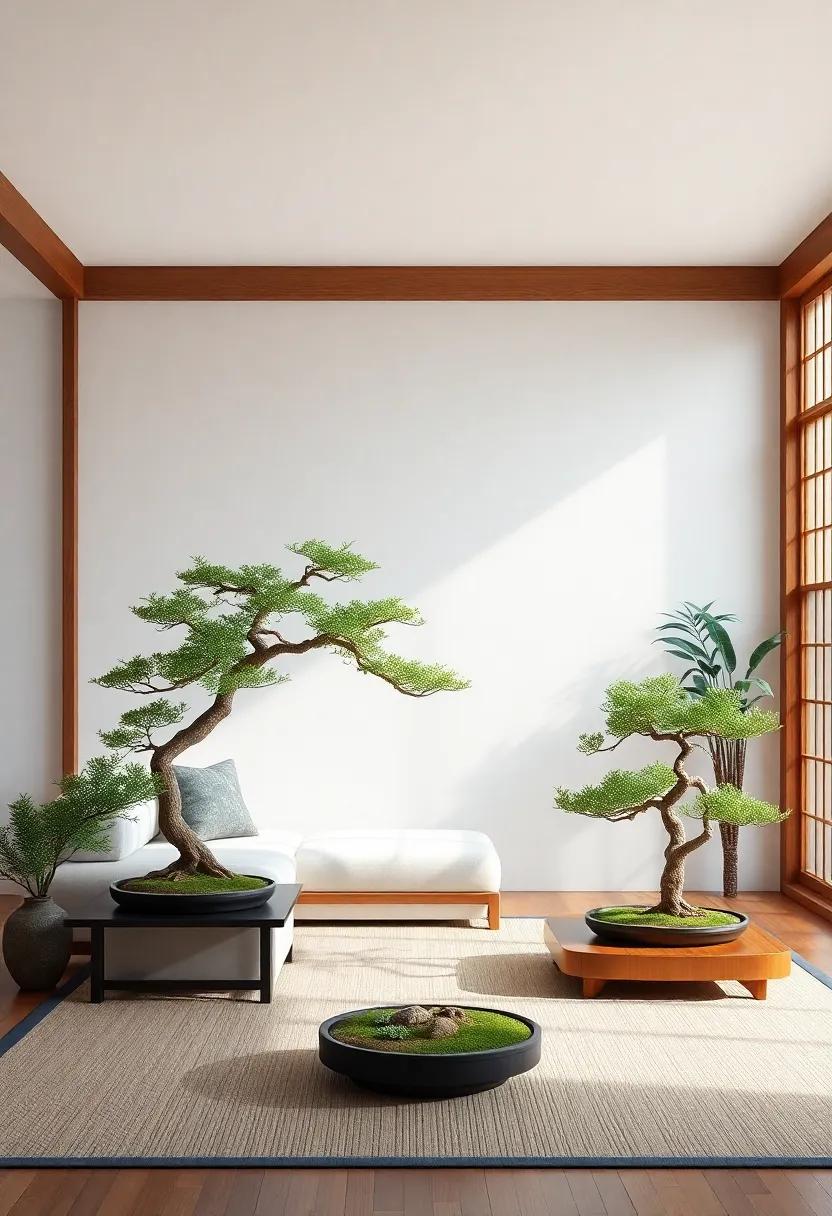
When it comes to selecting bonsai varieties for your living room, it’s essential to consider both aesthetics and compatibility with your indoor environment. Certain species thrive better in the controlled conditions of a home than others.Ficus, as an example, is an excellent choice due to its resilience and ability to flourish in lower light levels. Other popular varieties include Juniper, known for its beautiful needle-like foliage, and Chinese Elm, which embodies a classic look. Each of these trees offers unique textures and shapes that can complement your Japanese-inspired decor beautifully.
To help guide your selection process, consider the following factors:
- Light Requirements: Assess how much natural light your space receives.
- Temperature stability: Ensure your living room maintains a consistent climate.
- Size and Shape: Choose a bonsai that fits well with your furnishings and space.
Here’s a simple comparison table showcasing some popular bonsai varieties ideal for indoor settings:
| Variety | Light needs | Watering Frequency |
|---|---|---|
| Ficus | Moderate | Weekly |
| Juniper | Bright | Every 5 days |
| Chinese Elm | Low to Moderate | Weekly |
Scent and sensibility: Essential Oils to Elevate Your Ambiance
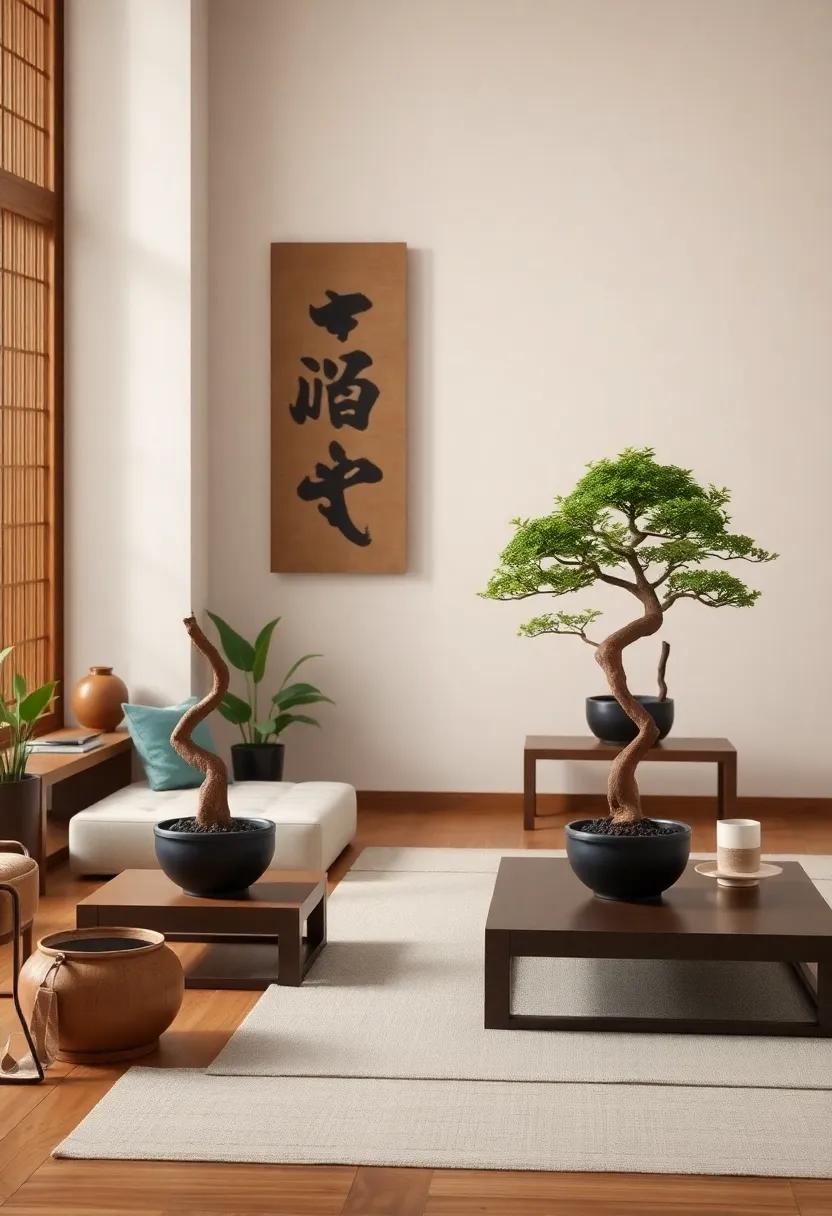
Creating a serene atmosphere in your Japanese-inspired living room goes beyond aesthetics; scent plays a pivotal role in enhancing your space. Essential oils can invigorate your senses while promoting relaxation. Here are some top choices to consider:
- Lavender: Known for its calming properties, it helps reduce stress and promotes restful sleep.
- Sandalwood: This warm and earthy aroma fosters a meditative environment, perfect for moments of tranquility.
- Bergamot: With its refreshing citrus notes,it uplifts spirits and creates an inviting ambiance.
- Eucalyptus: Clean and crisp, it clears the mind, making it easier to focus on mindfulness activities.
To seamlessly incorporate these essential oils into your living room design, consider using a diffuser for a consistent aroma throughout the day. You may also want to explore the option of creating an essential oil blend, allowing you to tailor the ambiance to your mood. Here’s a simple blend to get started:
| Ingredient | Amount |
|---|---|
| Lavender Essential Oil | 10 drops |
| sandalwood Essential Oil | 5 drops |
| Bergamot Essential Oil | 7 drops |
Mix these oils with a carrier oil or water in your diffuser, and let the enchanting fragrance transform your living space. The right scent can enhance the beauty of your bonsai trees while creating a harmonious retreat that embraces tranquility.
Gathering Spaces: Creating Areas for Connection and Conversation
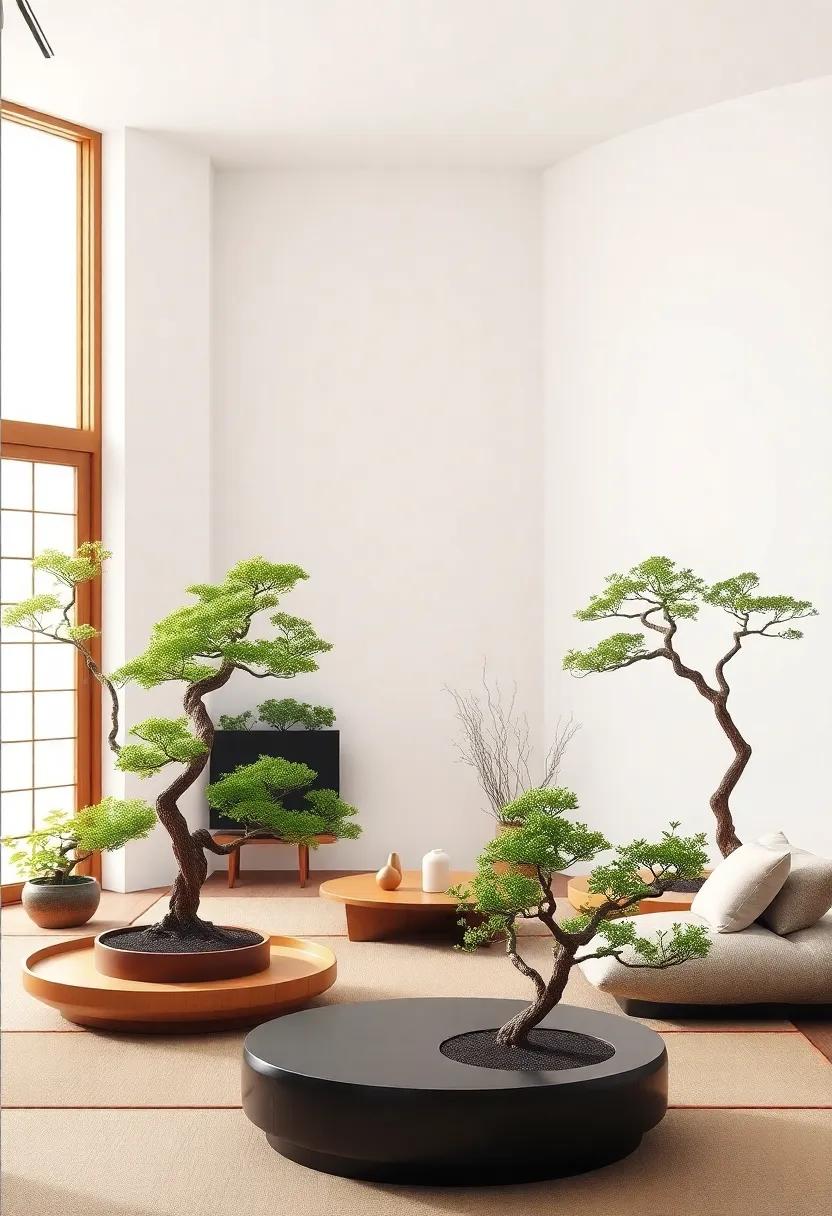
Incorporating gathering spaces within a Japanese-inspired living room can foster meaningful interactions and genuine connections. Consider integrating elements that invite conversation, such as:
- low Seating: Use floor cushions or low tables that encourage a relaxed posture, making it easy to engage with others.
- Natural Materials: Opt for wooden or bamboo furniture that resonates with the natural aesthetic, creating a warm and inviting atmosphere.
- Zen Gardens: A miniature zen garden can serve as a centerpiece, inviting guests to pause, reflect, and converse about its serene beauty.
Additionally, the careful arrangement of bonsai trees can enrich this tranquil environment. Placing these miniature masterpieces in strategic spots can enhance the ambiance and stimulate dialogue around their cultural significance. Some ideas to consider include:
- Corner Displays: Positioning a bonsai in a corner can draw the eye and become a natural focal point.
- Group Installations: Arranging multiple bonsai trees on a shelf creates a curated look that encourages discussion about each plant’s unique characteristics.
- Interactive Elements: Provide tools and educational materials for guests to learn about proper care techniques and the art of bonsai cultivation.
In Summary
As we draw the curtains on our journey into the serene world of Japanese-inspired living rooms adorned with the elegance of bonsai trees,let us reflect on the profound tranquility that such a space can cultivate. This design philosophy, steeped in centuries of tradition, invites nature into the heart of our homes, fostering a sanctuary where the hustle and bustle of modern life can fall away. By thoughtfully incorporating minimalist aesthetics, natural materials, and the gentle presence of bonsai, we create not just a living room, but a personal retreat—a reflection of harmony and balance.
As you embark on your own design adventure, remember that each element is an opportunity to express your unique interpretation of peace. Allow the bonsai to be more than a decorative piece; let it be a reminder to cultivate mindfulness in your everyday life. So, breathe deeply, embrace the calm, and transform your living space into a harmonious haven that echoes the beauty of nature. In doing so, you may just find that tranquility is not only a design choice but a way of being.
As an Amazon Associate I earn from qualifying purchases.



